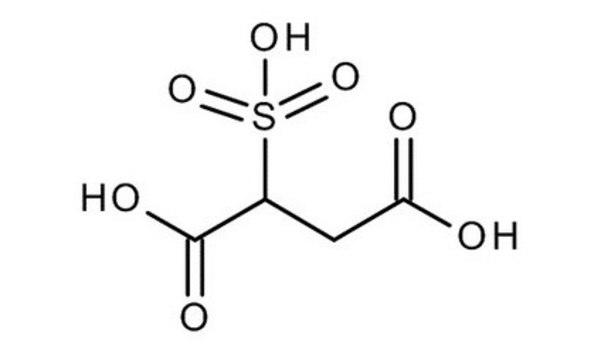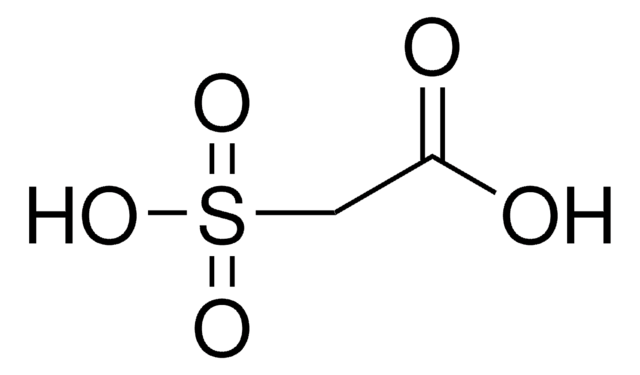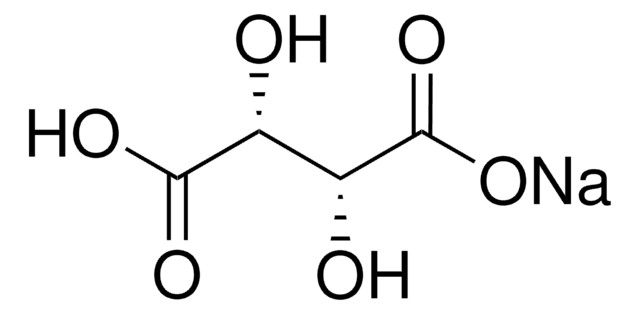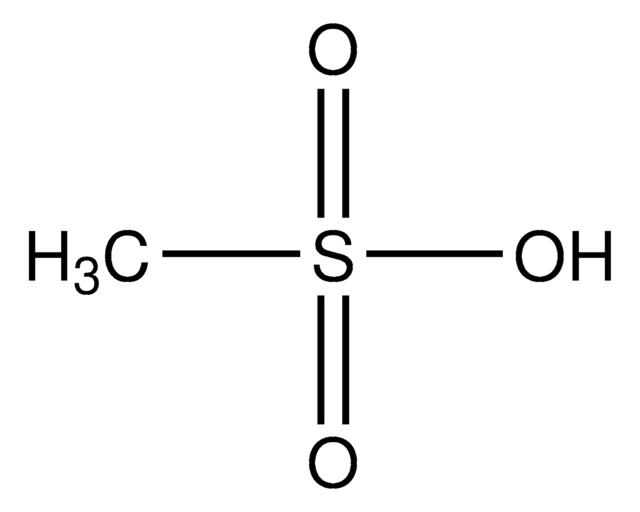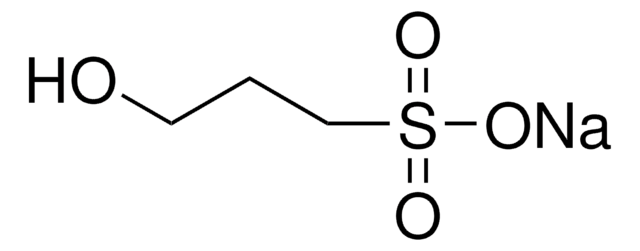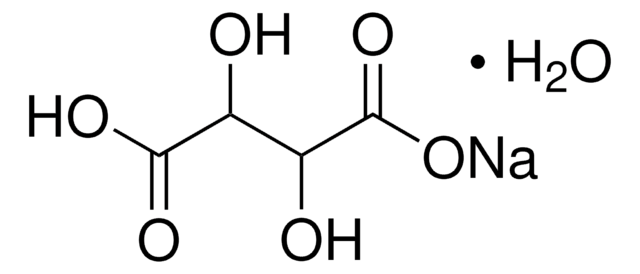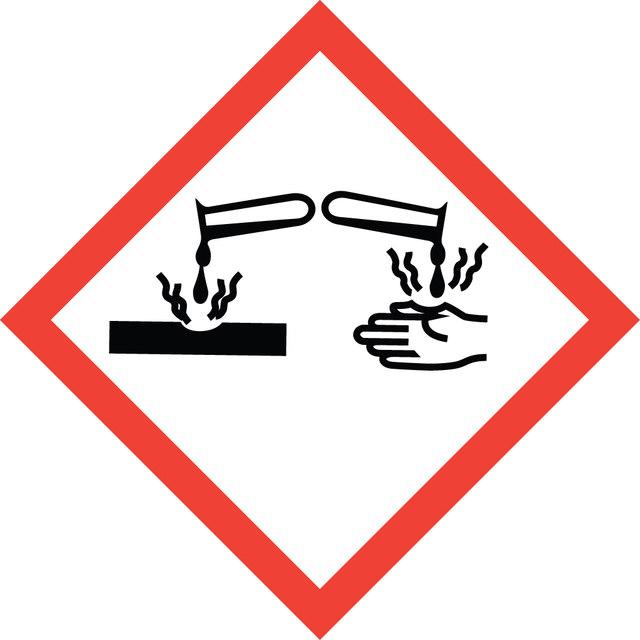338567
Sulfosuccinic acid solution
70 wt. % in H2O
Synonym(s):
2-Sulfobutanedioic acid
Sign Into View Organizational & Contract Pricing
All Photos(1)
About This Item
Linear Formula:
HOOCCH2CH(SO3H)COOH
CAS Number:
Molecular Weight:
198.15
Beilstein:
1727687
MDL number:
UNSPSC Code:
12162002
PubChem Substance ID:
NACRES:
NA.23
Recommended Products
form
viscous liquid
Quality Level
concentration
70 wt. % in H2O
refractive index
n20/D 1.449
density
1.438 g/mL at 25 °C
SMILES string
OC(=O)CC(C(O)=O)S(O)(=O)=O
InChI
1S/C4H6O7S/c5-3(6)1-2(4(7)8)12(9,10)11/h2H,1H2,(H,5,6)(H,7,8)(H,9,10,11)
InChI key
ULUAUXLGCMPNKK-UHFFFAOYSA-N
Looking for similar products? Visit Product Comparison Guide
Application
- Modification of nanocellulose membrane by impregnation method with sulfosuccinic acid for direct methanol fuel cell applications: This study examines the use of sulfosuccinic acid in various concentrations to improve the properties of nanocellulose membranes for fuel cells (Sriruangrungkamol & Chonkaew, 2021).
- A high-strength polyvinyl alcohol hydrogel membrane crosslinked by sulfosuccinic acid for strontium removal via filtration: Research focusing on using sulfosuccinic acid to enhance polyvinyl alcohol hydrogel membranes for effective strontium filtration (Yoon et al., 2019).
- Cross-linked poly (vinyl alcohol)/sulfosuccinic acid polymer as an electrolyte/electrode material for H2–O2 proton exchange membrane fuel cells: This paper discusses the application of sulfosuccinic acid in creating cross-linked polyvinyl alcohol for fuel cell membranes (Ebenezer et al., 2016).
- Preparation of chitosan/polyvinyl alcohol blended films containing sulfosuccinic acid as the crosslinking agent using UV curing process: An investigation into using sulfosuccinic acid to crosslink chitosan/polyvinyl alcohol films for improved mechanical properties (Yun et al., 2017).
- Investigation on resistive humidity sensing in sulfosuccinic acid doped polyaniline films: This research explores the potential of sulfosuccinic acid doped polyaniline films for humidity sensing applications (Biswas et al., 2021).
Signal Word
Danger
Hazard Statements
Precautionary Statements
Hazard Classifications
Eye Dam. 1 - Skin Corr. 1B
Storage Class Code
8A - Combustible corrosive hazardous materials
WGK
WGK 3
Flash Point(F)
Not applicable
Flash Point(C)
Not applicable
Choose from one of the most recent versions:
Already Own This Product?
Find documentation for the products that you have recently purchased in the Document Library.
A Quick et al.
Microbiology (Reading, England), 140 ( Pt 11), 2991-2998 (1994-11-01)
The bacterial biodegradation of a secondary sulphonate, sulphosuccinate, has been shown to occur by direct desulphonation. A bacterium, designated Pseudomonas sp. BS1, was isolated from activated sewage sludge, for its capacity to grow on sulphosuccinate as the sole source of
Jun Kim et al.
Water research, 160, 445-453 (2019-06-08)
Technologies capable of selective removal of target contaminants from water are highly desirable to achieve "fit-for-purpose" treatment. In this study, we developed a simple yet highly effective method to achieve calcium-selective removal in an electrosorption process by coating the cathode
Jeffrey Childs et al.
Journal of contaminant hydrology, 82(1-2), 1-22 (2005-10-20)
This study reports on a surfactant-based flood for tetrachloroethylene (PCE) removal from a control test cell at the Dover National Test Site. The surfactant formulation (sodium dihexyl sulfosuccinate (Aerosol-MA or AMA), isopropanol and calcium chloride) was able to achieve a
Stability and activity of acid phosphatase in reverse micelles.
M Cantarella et al.
Annals of the New York Academy of Sciences, 750, 97-100 (1995-03-31)
T P Alekseeva et al.
Izvestiia Akademii nauk. Seriia biologicheskaia, (4)(4), 403-410 (2010-08-31)
Comparative study of chitosan wound healing properties and its synthesized derivatives in MC-100 gel was carried out using the model of experimental full thickness skin wounds. It was determined that N-sulfosuccinoyl chitosan derivatives added into the gel in a concentration
Our team of scientists has experience in all areas of research including Life Science, Material Science, Chemical Synthesis, Chromatography, Analytical and many others.
Contact Technical Service